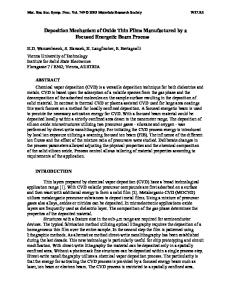Electrochemical Synthesis of Molybdenum Oxide Thin Films: Deposition Mechanism and Template-Directed Assembly of Nanostr
- PDF / 341,401 Bytes
- 11 Pages / 612 x 792 pts (letter) Page_size
- 34 Downloads / 365 Views
Z1.1.1
Electrochemical Synthesis of Molybdenum Oxide Thin Films: Deposition Mechanism and Template-Directed Assembly of Nanostructured Materials and Components Todd M. McEvoy, Hugo Celio, Emily E. Barton, and Keith J. Stevenson University of Texas at Austin Department of Chemistry and Biochemistry Austin, TX 78712 ABSTRACT We describe the electrochemical deposition of molybdenum oxide thin films prepared from aqueous solutions containing peroxo-poly and oxometallate complexes of molybdenum(VI). Electrochemical quartz crystal microgravimetry (EQCM) was used to establish corresponding reaction mechanisms for films grown at different deposition potentials. Electrodeposition from acidified sodium molybdate solutions proceeds by the reduction of molybdic acid; whilst deposition from aqueous peroxo-based solutions involves the graded reduction of several solution components, primarily comprising molybdic acid and peroxopolymolybdates. Films grown from acidified sodium molybdate solutions are weakly adherent and easily rinsed off, while those grown from peroxo-polymolybdate solutions are strongly attached and stable. Careful regulation of the deposition potential allows for controlled growth of distinct molybdenum oxide compositions to produce films with varied water content and valency. Electrochemical deposition through sacrificial colloidal-crystal templates is also demonstrated to prepare macroporous thin films comprising hexagonally close-packed arrays of spherical pores. INTRODUCTION Metal oxides (e.g., MoO3, TiO2, and MnO2) have offered great promise for use in the context of batteries[1], electrochromics[2], photonic materials[3], and catalysts[4]. The desire to improve application performance has spurred the development of new classes of mesoporous materials such as aerogel[5], surfactant templated[6], and colloidal-crystal templated[7,8] thin films. Current interest in these materials has arisen not only due to their unique structural properties of high surface area and high porosity but also because their synthetic preparation allows for improved control of chemical composition and mesostructure (e.g., pore size, distribution and orientation). For instance, Dunn and co-workers[9] have employed a colloidalcrystal templating approach to create highly ordered, macroporous V2O5. When used as Li+ insertion hosts, templated V2O5 materials exhibit higher discharge capacities at faster discharge rates versus non-templated analogs. The purposeful tailoring of pore spacing and geometry enhances mass transport of intercalate ions through the material by minimizing tortuosity and promoting rapid ion mobility, dramatically decreasing ion diffusion lengths, and significantly increasing ion diffusion rates. Martin et al.[10] have utilized similar approaches to prepare nanofibril structured cathodes and anodes based on carbon, SnO2, LiMn2O4 and V2O5 by templating from porous polycarbonate or alumina membranes. These battery materials have demonstrated exceptional rate capabilities and improved volumetric energy densities. In g
Data Loading...











